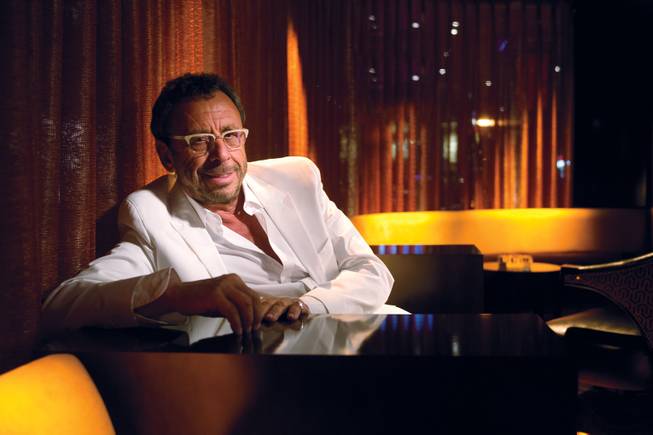
Las Vegas nightlife pioneer Victor Drai will celebrate a milestone in two weeks when Drai’s After Hours, which started as a restaurant on the Strip in 1997, turns 20.
Sunday, June 11, 2017 | 2 a.m.
Victor Drai stands as one of Las Vegas' great visionaries, and this month marks the 20th anniversary of his passion project — Drai's After Hours.
The pioneering club is, in many ways, the place where the reinvention of the contemporary Vegas nightlife scene started.
In the minds of most visitors and locals, the Las Vegas nightclub experience is all about the big and the new. Millions of people spend millions of dollars every year to party like there’s no tomorrow inside flashy, massive mega-clubs, hot spots that compete head-to-head every week for the mythological title of The Place To Be. It’s not in a Vegas nightclub’s nature to last very long, and yet Drai’s After Hours has done just that, finding steady success and even legendary status for two decades now — defying most conventions while sticking to the most important rules of the game: Stay cool, and stay open late.
The club will celebrate its 20th birthday on the Las Vegas Strip on June 25. Originally opened by Victor Drai as a restaurant in 1997, it began full-on club operations in 1999 and has weathered much more than the ever-changing Vegas nightlife landscape. For most of its life, Drai’s was in the basement of the Barbary Coast, lending an aura of modern hipness to the Gold Rush-themed casino that had struggled to find its footing as a nightlife spot.
Sold to Caesars Entertainment — then Harrah’s — in 2007, the property was renamed Bill’s Gamblin’ Hall before being fully rebranded as the Cromwell in 2014.
Through all the changes, Drai’s has remained, drawing a dedicated and diverse crowd to the center of the Strip for afterhours adventures that no other club has been able to match.
“I’m like the Switzerland of nightclubs. I’m not competing with anybody,” says Drai, the Moroccan-born entrepreneur and former Hollywood film producer. “Anybody who has tried to do afterhours in Las Vegas is all gone, because it’s not a huge business. Sometimes something will open and take 20 or 30 or even 50 percent of my business for a while, but it’s still not enough. They all fail.”
Drai’s After Hours is typically open from 1 until 10 a.m. Thursday through Sunday. It stretches over 13,000 square feet, including four lounge-ish rooms usually providing two different musical formats, 55 tables and multiple bars. Drai has made only subtle changes over the years, applying the classic if-it-ain’t-broke method of management, keeping the place fresh and fun but swanky — and red — as ever.
“After Hours is his baby, his first creation, and it’s incredibly special to him and to the marketplace,” says Michael Gruber, Drai’s managing partner for nearly eight years. “I’ve known Victor for almost 30 years from the entertainment and movie business, the film industry, and he definitely comes with a legacy in diversified entertainment.”
Drai’s background was essential to building the mystique of the long-running party spot. His aesthetic was unlike any other Vegas venue, even before Drai’s transitioned from restaurant to club.
“I always knew I wanted to do something with music,” he says. “So when I designed the restaurant, because it was underground, I designed it more like a club, so the feeling was always more clubby than restaurant.” When some DJs who had started a weekly promotion at Mandalay Bay’s China Grill approached him about taking the space over after restaurant hours on Wednesday nights, Drai gave them a shot. Eventually he hosted a special event afterparty on a Saturday night and packed the place, deciding then to seize the opportunity.
Drai pioneered bottle service in Las Vegas at After Hours, before Light Nightclub did it at Bellagio and set the trend for the future. The club also changed the sound of Vegas nightlife. “After Hours has always been on the cutting edge of music. It was the first to do EDM (electronic dance music),” says Gruber.
After Hours has always offered plentiful house music, thanks in part to longtime musical director and DJ Chris Garcia. In recent years, Garcia brought in DJ Direct to lead the hip-hop charge, keeping the club’s soundtrack diverse. “We try to keep it as diverse as possible because this city is as diverse as you can possibly get,” says Bobby Minkoff, director of VIP services and marketing, who has been at After Hours for 10 years. “We used to never close After Hours before 9 a.m. and it was the (clientele) in the house room that kept us open. They would stay and rage and party until 10 on the weekends. But now there are nights when that flip-flops and the hip-hop room carries the night.”
After Hours also distinguishes itself from other Strip nightclubs with its long-devoted crowd of locals, mostly hospitality industry workers who are looking for something more than a bar when they get off work in the wee hours — they’re looking for each other.
“I can walk up to the door at any nightclub in the city, and because of what our venue does for everyone else, I’m welcomed with open arms,” says Minkoff. “And in turn, they come see us, every single week. The hospitality is reciprocated back and forth, and that’s one of the most fun parts about it.”
Everybody knows exactly what kind of vibe they’re going to get at Drai’s, the closest thing the Strip has today to the formerly popular ultralounge concept, a smaller venue where there was music and edge but also intimacy and natural social interaction. For that crowd, After Hours is less an afterparty and “more the main attraction,” Gruber says. “Big nightclubs these days aren’t as much of the boy-meets-girl type of places. By the time you’re at those nightclubs with your group, even within those groups it’s hard to talk. You’re there for the big DJ. But after that, when you’re feeling great and you still have a lot of energy, you’re looking for a real club atmosphere, and that’s what After Hours offers.”
Victor Drai’s 23-year-old son, Dustin, has been part of the business for about a year now, working in multiple roles but mainly as a talent coordinator for Drai’s Beachclub and Nightclub on the roof of the Cromwell — the larger, indoor-outdoor venue that opened in 2014 and has established a different reputation, for live performances and hip-hop music.
It’s only been a few years since Dustin could officially partake in the wonders of After Hours, but of course he’s very familiar with the club. “I grew up in there. I used to run around the reception desk and answer the phone, and on New Year’s Eve my dad would sneak me into the club right before midnight and we’d go up on the roof of the Barbary Coast to watch fireworks,” he says. “I’ve seen so many different, little changes over the years, but the authenticity, what I remember as a kid, is exactly the same.”
Dustin Drai represents the next generation of Vegas clubbers, one that’s still interested in a legendary afterhours spot where the previous generation made so many memories.
“My generation is definitely still going, because we heard all these stories about what it was, what’s happened at After Hours, from all these locals who have gotten out of the scene because they have kids and families now,” he says. “We want to have those experiences for ourselves and bring our friends. That’s why Drai’s has been able to keep going. There’s so much history for that next wave of people.”





Join the Discussion:
Check this out for a full explanation of our conversion to the LiveFyre commenting system and instructions on how to sign up for an account.
Full comments policy